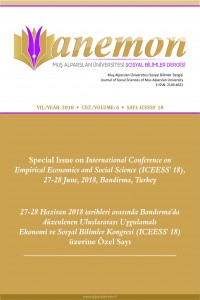Abstract
The date of the first
devaluation in Turkey's economy is seen as 1946. After this date, we see that
the Turkish lira was devalued according to economic needs at various periods.
In fact, it is much more important to make a gain to the country depending on its
effect after it is made much from the devaluation. This gain is expected to
increase the country's exports and reduce existing imports. The occurrence of
this condition is due to Marshall-Lerner condition. In this context, working
with Marshall-Lerner condition of literature and the theoretical framework in
looking, Turkey and her trading partners 1950-2000 year data with the import
and export equation obtained in the light of the Marshall-Lerner condition is
examined.
References
- Aksu, M. (2007). Marshall – Lerner Yaklaşımı Çerçevesinde Reel Döviz Kuru ve Ticaret Dengesi Arasındaki İlişki: Kuram ve Türkiye Örneği. Yüksek Lisans Tezi. Aydın: Adnan Menderes Üniversitesi.
- Bozdağlıoğlu, U. Y. E. (2007). Türkiye’nin İthalat ve İhracatının Eşbütünleşme Yöntemi İle Analizi (1990-2007). Gazi Üniversitesi İktisadi ve İdari Bilimler Fakültesi Dergisi, 3(9), 213 –224.
- Cambazoğlu, B., & Güneş, S. (2016). Marshall-Lerner Condition Analysis: Turkey Case. Economics, Management, and Financial Markets, 11(1), 272–283.
- Dickey, D. A., & Fuller, W.A. (1979). Distribution of the Estimators for Autoregressive Time Series with a Unit Root. Journal of The American Statistical Society, 75, 427–431.
- Göçer, İ., & Elmas, B. (2013). Genişletilmiş Marshall-Lerner Koşulu Çerçevesinde Reel Döviz Kuru Değişimlerinin Türkiye'nin Dış Ticaret Performansına Etkileri: Çoklu Yapısal Kırılmalı Zaman Serisi Analizi. BDDK Bankacılık ve Finansal Piyasalar Dergisi, 1(7),137-157.
- Jamilov, R. (2013). J-Curve Dynamics and the Marshall–Lerner Condition: Evidence from Azerbaijan. Transition Studies Review,19(3),313–323.
- Kemeç, A., & Kösekahyaoğlu, L. (2015). J Eğrisi Analizi ve Türkiye Üzerine Bir Uygulama. Uluslararası İktisadi ve İdari Bilimler Dergisi, 2(1), 4-29.C
- Lerner, A. P. (1944). The Economics of Control: Principles of Welfare Economics. Newyork: The Macmillan Yayınları, 50-78.
- MacKinnon, J. G. (1991). Critical Values for Cointegration Tests. İçinde: R.F. Engle & C.W.J. Granger (Ed.), Long-run Economic Relationships (s.130-158). Oxford: Oxford University Yayınları.
- Mahmud, S. F., Ullah, A., & Yucel, M. E. (2004). Testing Marshall-Lerner Condition: A Non-Parametric Approach. Applied Economics Letters, 4(11), 231-236.
- Miles, M. A. (1979). The Effects of Devaluation on the Trade Balance and the Balance of Payment: Some New Results. Journal of Political Economy, 6(4), 600-620.
- Oskooee, B. M., & Ratha, A. (2004). The J-Curve: A Literature Review. Applied Economics, 13(36), 1377-1398.
- Vergil, H., & Erdoğan, S. (2009). Döviz Kuru-Ticaret Dengesi İlişkisi: Türkiye Örneği. Uluslararası Yönetim İktisat ve İşletme Dergisi, 9(5), 35-57.
Abstract
Türkiye ekonomisinde ilk devalüasyonun yapıldığı tarih
1946 yılı olarak görülmektedir. Devalüasyon sonrasında ülkenin ihracatını
artırması ve mevcut ithalatını azaltması şeklinde olması beklenir. Bu durumun
oluşması ise marshall-lerner koşuluna
bağlı olarak ortaya çıkmaktadır. Çalışmada, Türkiye ve Türkiye'nin dış ticaret
ortaklarının 1950-2000 yıllarında sabit döviz kuru rejimine yakın olduğu
veriler ışığında elde edilen ithalat ve ihracat denklemi ile marshall-lerner
koşulu incelenmiştir. Elde edilen sonuçlara göre marshall-lerner koşulunda
sağlıklı bir devalüasyonu gösteren ithal ve ihraç malları talep esnekliklerinin
toplamının 1’den büyük durumunun zayıf bir değerle geçildiği görülmektedir.
Ayrıca, Türkiye’nin ihraç malları fiyat elastikiyeti () değeri teoride beklenen değerden (beklenen değer
1’den büyük olması) daha düşük çıktığı görülmüştür. Bunun sonucu olarak
Türkiye’nin ürettiği ihraç mallarının daha çok inelastik mallar (() (0.74) < 1 ) olduğunu söyleyebiliriz.
References
- Aksu, M. (2007). Marshall – Lerner Yaklaşımı Çerçevesinde Reel Döviz Kuru ve Ticaret Dengesi Arasındaki İlişki: Kuram ve Türkiye Örneği. Yüksek Lisans Tezi. Aydın: Adnan Menderes Üniversitesi.
- Bozdağlıoğlu, U. Y. E. (2007). Türkiye’nin İthalat ve İhracatının Eşbütünleşme Yöntemi İle Analizi (1990-2007). Gazi Üniversitesi İktisadi ve İdari Bilimler Fakültesi Dergisi, 3(9), 213 –224.
- Cambazoğlu, B., & Güneş, S. (2016). Marshall-Lerner Condition Analysis: Turkey Case. Economics, Management, and Financial Markets, 11(1), 272–283.
- Dickey, D. A., & Fuller, W.A. (1979). Distribution of the Estimators for Autoregressive Time Series with a Unit Root. Journal of The American Statistical Society, 75, 427–431.
- Göçer, İ., & Elmas, B. (2013). Genişletilmiş Marshall-Lerner Koşulu Çerçevesinde Reel Döviz Kuru Değişimlerinin Türkiye'nin Dış Ticaret Performansına Etkileri: Çoklu Yapısal Kırılmalı Zaman Serisi Analizi. BDDK Bankacılık ve Finansal Piyasalar Dergisi, 1(7),137-157.
- Jamilov, R. (2013). J-Curve Dynamics and the Marshall–Lerner Condition: Evidence from Azerbaijan. Transition Studies Review,19(3),313–323.
- Kemeç, A., & Kösekahyaoğlu, L. (2015). J Eğrisi Analizi ve Türkiye Üzerine Bir Uygulama. Uluslararası İktisadi ve İdari Bilimler Dergisi, 2(1), 4-29.C
- Lerner, A. P. (1944). The Economics of Control: Principles of Welfare Economics. Newyork: The Macmillan Yayınları, 50-78.
- MacKinnon, J. G. (1991). Critical Values for Cointegration Tests. İçinde: R.F. Engle & C.W.J. Granger (Ed.), Long-run Economic Relationships (s.130-158). Oxford: Oxford University Yayınları.
- Mahmud, S. F., Ullah, A., & Yucel, M. E. (2004). Testing Marshall-Lerner Condition: A Non-Parametric Approach. Applied Economics Letters, 4(11), 231-236.
- Miles, M. A. (1979). The Effects of Devaluation on the Trade Balance and the Balance of Payment: Some New Results. Journal of Political Economy, 6(4), 600-620.
- Oskooee, B. M., & Ratha, A. (2004). The J-Curve: A Literature Review. Applied Economics, 13(36), 1377-1398.
- Vergil, H., & Erdoğan, S. (2009). Döviz Kuru-Ticaret Dengesi İlişkisi: Türkiye Örneği. Uluslararası Yönetim İktisat ve İşletme Dergisi, 9(5), 35-57.
Details
| Primary Language | Turkish |
|---|---|
| Journal Section | Research Article |
| Authors | |
| Publication Date | December 15, 2018 |
| Acceptance Date | September 4, 2018 |
| Published in Issue | Year 2018 Volume: 6 Issue: ICEESS’ 18 |
Anemon Muş Alparslan Üniversitesi Sosyal Bilimler Dergisi Creative Commons Atıf-GayriTicari 4.0 Uluslararası Lisansı (CC BY NC) ile lisanslanmıştır.


